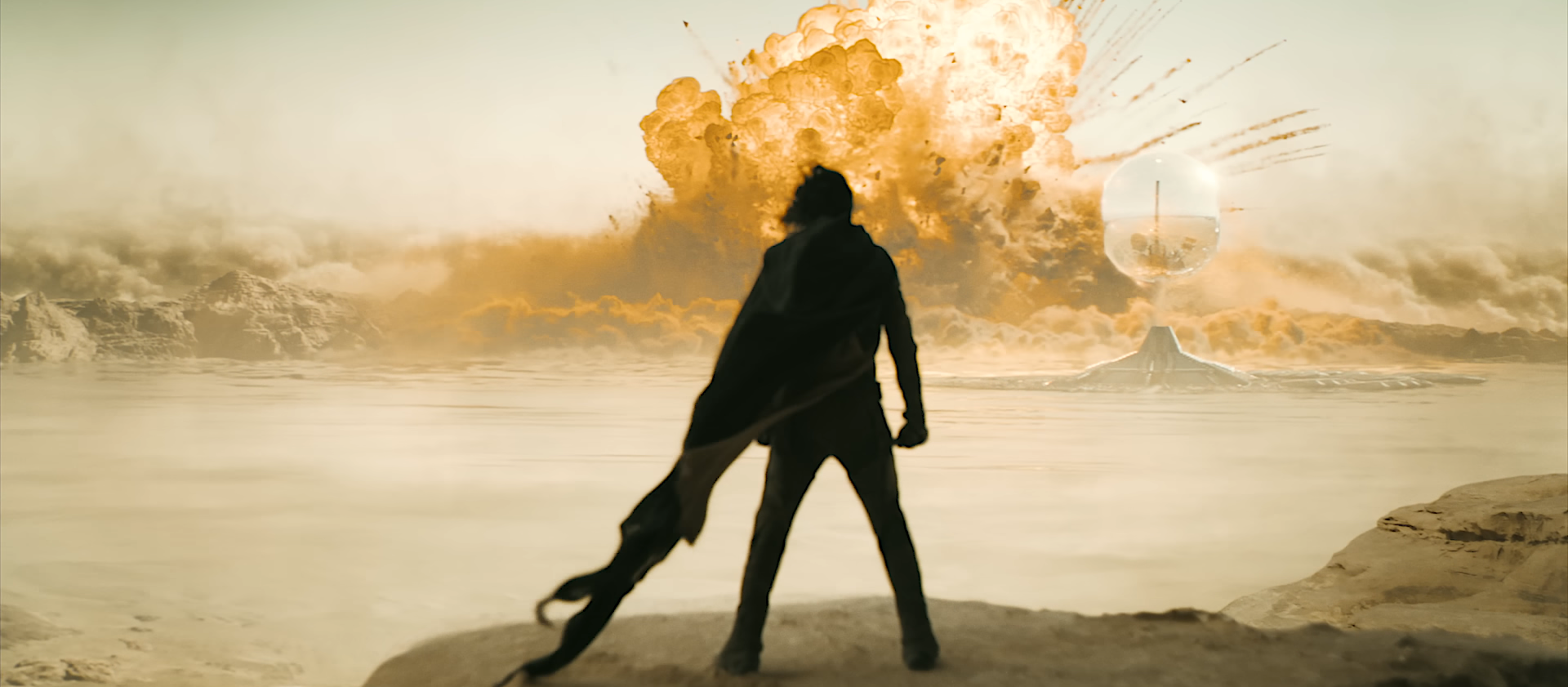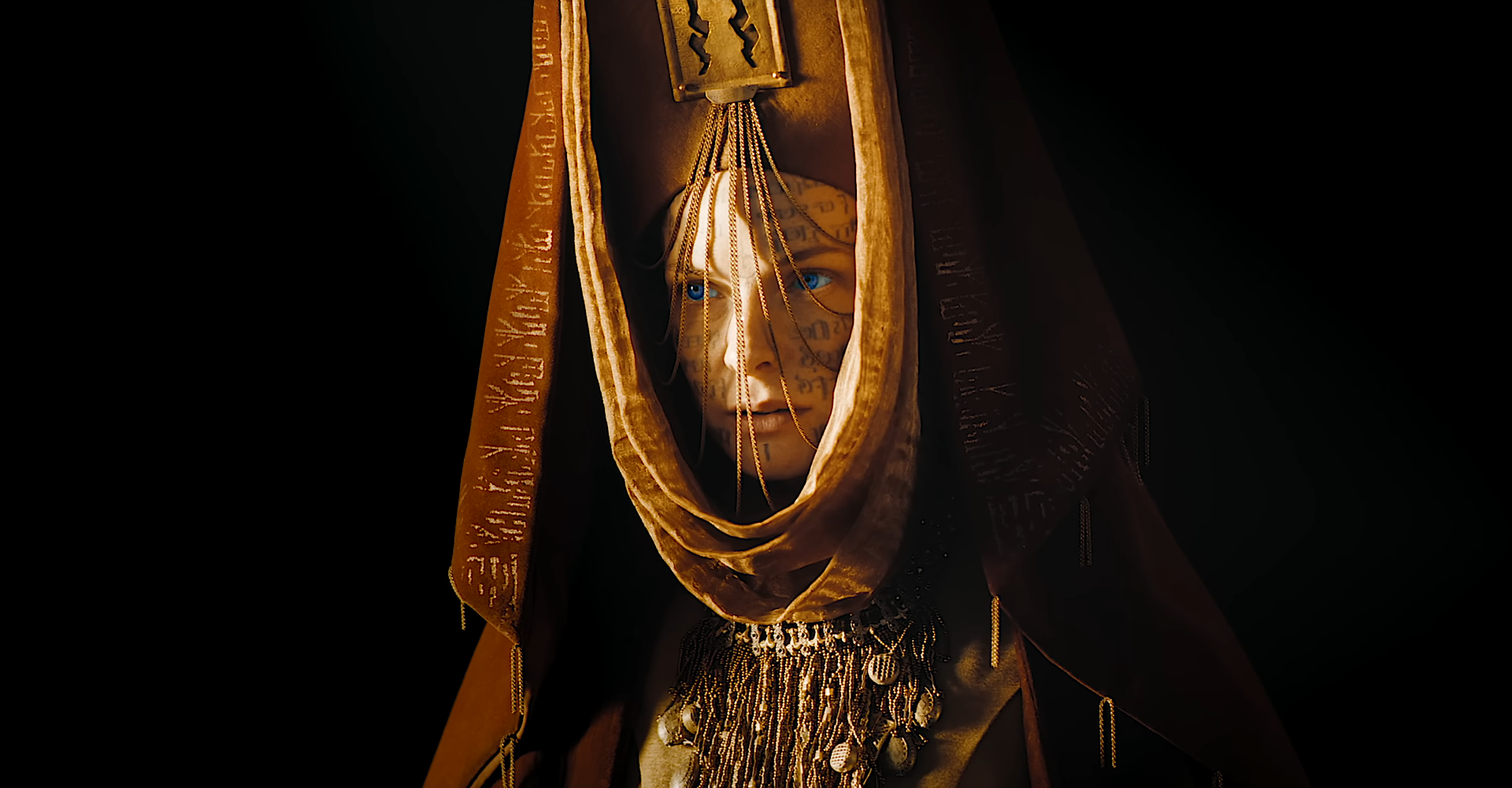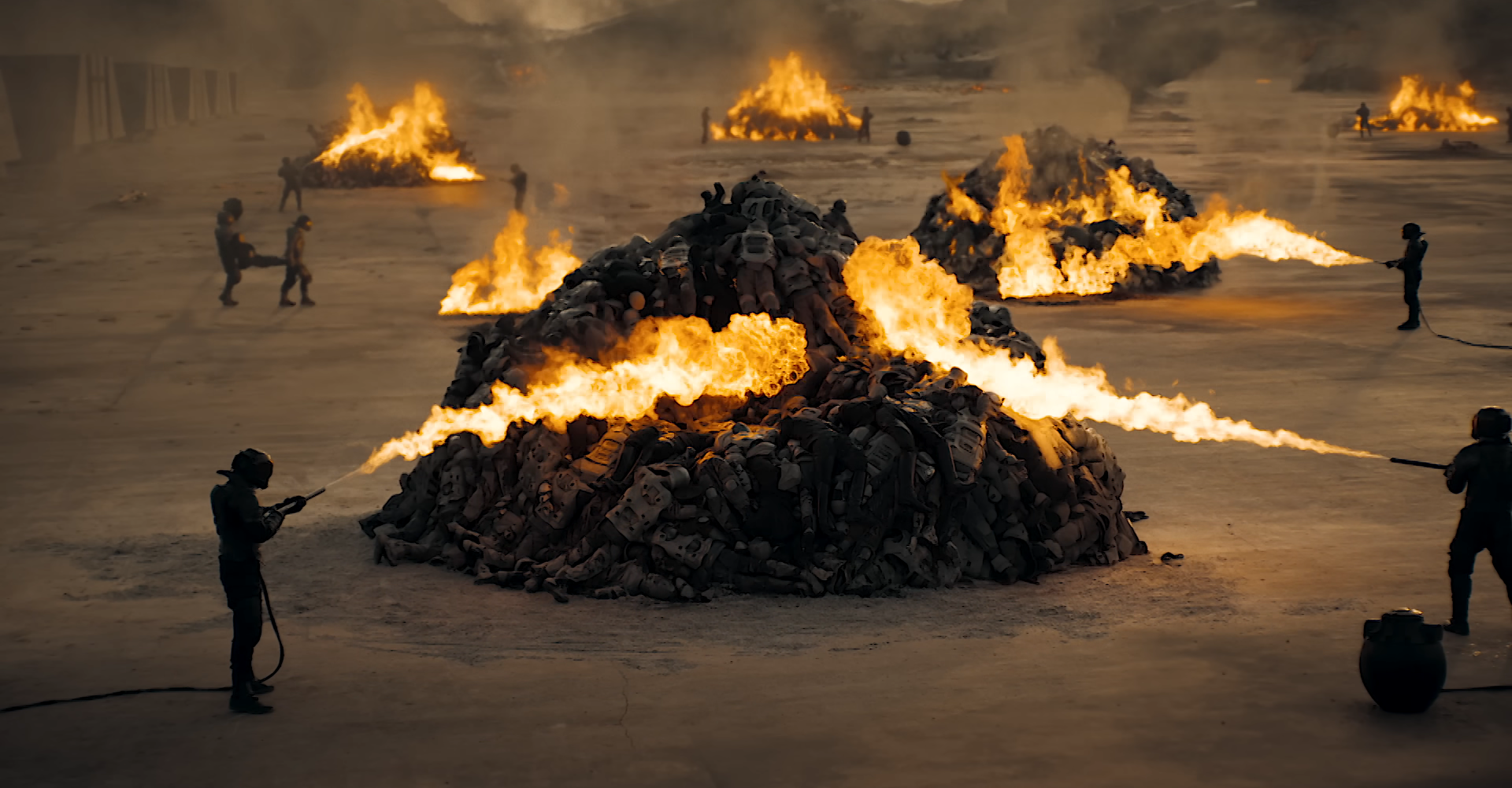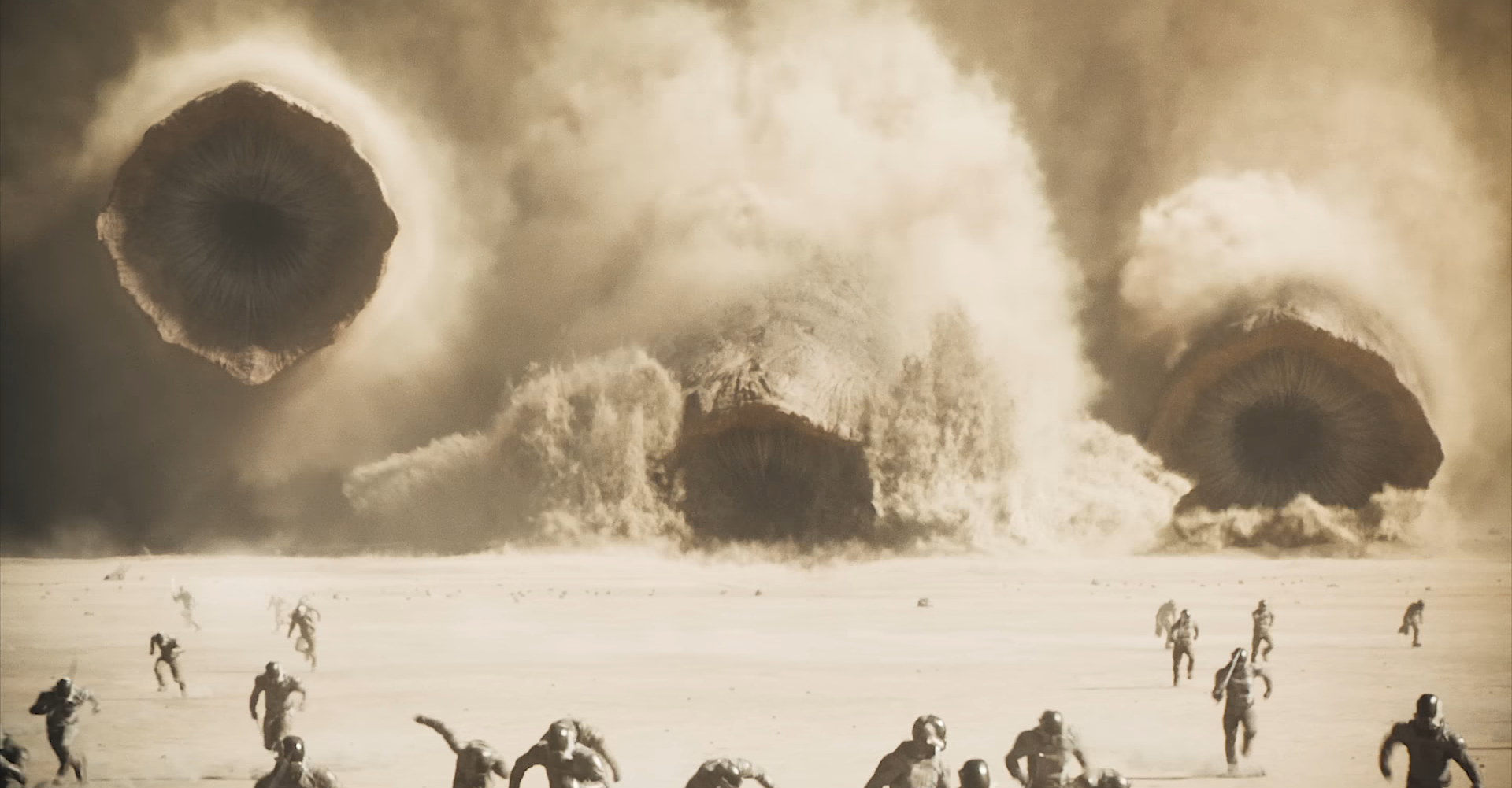

“He who can destroy a thing has the real control of it.”
One of the distressing things about a beloved novel getting adapted into a Hollywood blockbuster is that the hardcore fan must now contend with legions of newbies who utterly and inevitably fail to grasp anything beyond the most basic themes and narrative outline of the work. While perusing a handful of Dune: Part Two reaction posts on various subreddits, I was reminded of the classic xkcd comic panel ‘Duty Calls’ in which the solitary stick figure tells his offscreen partner that he can’t come to bed because someone is wrong on the internet. In this case, many someones were wrong. I’ve seen this plot-beat-per-minute action set piece extravaganza described as slow-paced, the subtle manipulations of the Bene Gesserit dismissed as predictable, the harrowing tale of hero worship and the horrors it will unleash as lacking in catharsis.
(For those keeping track, the first criticism is just plain wrong; this thing is all muscle and no fat, and almost detrimentally so. The second misunderstands the religious and political backdrops that ensure the Bene Gesserit’s carefully dispersed prophecies can be used to control events on a galactic scale and, yes, even render them predictable. The third is a case of the viewer missing the thematic point entirely—indeed, there should be little catharsis in commencing a holy war that will claim the lives of billions, even if there’s a terrible euphoria in fathoming it.)
Forgive my snark. And please accept my own scattershot criticisms, which some may consider invalid and most of which have to do with the fact that Denis Villeneuve needed $200M to make this thing and also needs it to be successful enough that Legendary Pictures will cough up another $200M or more a few years from now so he can adapt Dune Messiah.

If the all-star cast of Dune: Part One wasn’t distracting enough, in Part Two we’ve added not one or two but at least five extremely well-known actors (Austin Butler, Florence Pugh, Léa Seydoux, Christopher Walken, Anya Taylor-Joy) in roles where they need to convince the viewer they are super not part of 21st century Western culture. The newcomers, especially Butler as a menacing psychopath and Pugh as the emperor’s daughter (and not especially Walken as the emperor), assimilate fairly well. Zendaya, however, who plays Chani, the love interest of leading man Timothée Chalamet’s Paul Atriedes, and who may as well be considered a newcomer because she was barely in Part One, noticeably struggles to give a convincing portrayal. Her weak characterization is made even more glaring by the constant presence of Javier Bardem as Stilgar, the leader of the Fremen tribe into which Paul and his mother Jessica (Rebecca Ferguson) are eventually accepted through trials of combat and ritual initiation, and which Chani is supposed to have grown up in.
Of course, Zendaya and Chalamet and Butler and Pugh and Taylor-Joy (who has like two seconds of screen time as a tease for the third film) probably account for a decent chunk of the film’s box office, as they can draw in gaggles of filmgoers who might have no desire to grasp the wider universe of Dune but enjoy seeing young attractive people up on the big screen. Other characters, especially the villains played by Walken, Butler, Dave Bautista, and Stellan Skarsgård tend toward caricature, which lends itself to Villeneuve’s broad, image-driven cinema that is more or less actor-proof with the trade-off that it lacks humanity.

There’s been a quote from the director floating around the internet in which he states he doesn’t care for dialogue, that he’s interested in pure sound and image because iconic moments are what lodge themselves in our subconscious and can profoundly affect us. He still includes dialogue because, again, he’s making an expensive Hollywood movie, but his style is driven by visual storytelling. It is edifying to consider that storytelling style in light of Villeneuve’s comment, because the intensive effort required to achieve the technically superior arrangement of sound and image works in concert with the film’s theme of traversing a predetermined path.
One might have liked to see some of Frank Herbert’s weirder ideas embraced in Villeneuve’s film—the mysticism, the psychedelia, the guild navigators, the Abomination of Alia (Taylor-Joy), the Water of Life, stillsuits, crawlers, thumpers, CHOAM, ruminations on ecology and economics. Maybe even axolotl tanks and face dancers, although those come later in the book series. (Note: Both David Lynch’s Dune and the 2000 Sci-Fi Channel miniseries includes some of the things these new films left out. Not to mention Jodorowsky’s Dune.) Some of these things are present in some form or another, but Villeneuve’s utter commitment to realizing an extremely tactile film universe doesn’t leave a lot of room for aberration. When we do get something unusual, like the baby sandworm being drowned and purged of its mind-bending blue serum or fallen enemies being drained of their water, it’s not presented as wild or strange but as commonplace within the film universe. Villeneuve’s tendency has always been toward lucidity, and here that means streamlining not only Herbert’s politics, ecology, and philosophy, but also his mesmerizing blend of conscious and subconscious perspectives as well as his notes of grotesquery, psychic peril, and psychosexual vulnerability. Much of that shaping of the material is surely an outgrowth of Villeneuve’s sensibilities, but you also can’t convince me that Paul’s mystical visions in this second part should be less awe-striking than those in the first, now that he’s fully embraced the spice. Methinks a boardroom meeting or two ensured that if nothing else, Dune: Part Two would be legible Hollywood cinema for the masses.

The partial exception to this general sense of tempering is the Bene Gesserit Sisterhood. A hyper-disciplined religious order that has, through millennia of mental and physical conditioning, achieved nigh-superhuman abilities that appear as magic to outsiders, the Reverend Mothers and their novitiates wield great sociopolitical power that they use to shape the course of history. They plant prophecies that can be exploited by their spiritual descendants as necessary, subtly manipulating entire populations over the course of centuries, but also steer individual conversations by using The Voice. Though Jessica may hold full conversations with her unborn child and undergo the spice agony, Villeneuve’s Bene Gesserit still do not equal the strange, mysterious, almost inhuman matriarchy of Herbert’s novels. Maybe the upcoming spin-off HBO show Dune: Prophecy will embrace the less mainstream qualities without the pressure of the real box office.
Dune: Part Two is almost three hours long, and its most obvious cinematic forebear is not Part One or Star Wars but Monty Python’s Life of Brian—just kidding—it’s David Lean’s Lawrence of Arabia, about a real-life self-styled messiah who travels to a foreign land and gets drunk on his own success as he comes to see the culture he’s assimilated into as a backdrop for his own self-actualization. Like Lean’s film, Part Two tells an epic story by zooming in on a series of vignettes. Villeneuve’s film comprises a plethora of individual moments—snatches of conversation, military skirmishes, feats of heroism, campfire bonding, religious questioning, pillow talk, drug-induced psycho-spiritual awakening, near-death experiences—and requires the viewer to either accept the barrage at face value as superlative entertainment or read between the lines and think on the ideas being doled out. (Pro-tip: You can also read the book.) In this way, it reads not as an adventure or action film like so many blockbusters but as a self-conscious cinematic myth à la George Miller’s Mad Max films.
DP Greig Fraser should get a lot of credit for the film’s magnificent sunsets and silhouettes and desert landscapes, and may even be considered as much of auteur as Villeneuve in terms of his approach. In any case, the most memorable instance of the image-driven storytelling style we’ve been discussing comes when the film introduces Butler’s Feyd-Rautha by abruptly jumping to Geidi Prime where the harsh sunlight casts the action in monochrome. Seemingly out of nowhere, we cut from the tribulations of the Atreides and the Fremen on Arrakis to a black-and-white gladiator fight in an impossibly vast coliseum, in which our baldheaded, eyebrowless, blood-lusting villain—who draws the same is-he-the-prophesied-one attention from the Bene Gesserit as Paul and becomes his short-lived rival—fights against drugged combatants as Uncle Vladimir (Skarsgård) looks on with his own twisted expectations. This striking imagery defines the mythic arena.

Just like Max Rockatansky or T. E. Lawrence, Paul Atreides is painfully self-aware that he’s a legend in the making, that his own role in the events to come is no longer a choice. Indeed, the central conflict of the story isn’t the Fremen vs. the Harkonnens but Paul’s internal strife and despair as he fights against the Bene Gesserit prophecies that indicate he will be the Fremen’s savior, that he will become a symbol at the expense of his humanity. Is it a manufactured prophecy? Does that matter? Is Paul actually a preternaturally gifted youngster or does the world just bend to his whims because everyone believes he is? Now that things are set in motion, can any one person stop them? Are all our efforts to change the world futile? It’s telling that the film’s resolution, the ancient prophecy finally fulfilled, is not triumphant but ominous.
The difference between Paul and the other characters mentioned is that upon consuming the Water of Life, he does become something more than merely human—like Dr. Manhattan in Alan Moore’s Watchmen, he can now glimpse the myriad paths spread before him as past, present, and future are beheld simultaneously. Like Neo in The Matrix, he can see through the surface of our universe and interact with the raw materials of space and time.
But in a more general sense, where Paul differs from the standard mythological hero—even Neo or Dr. Manhattan, Frodo Baggins or Luke Skywalker, or any other figure that fits into Joseph Campbell’s monomyth outlined in The Hero with a Thousand Faces (a list that excludes T. E. Lawrence)—is that his frame story isn’t built with the same moral framework as most of the other hero’s journeys familiar in popular culture. Good necessarily triumphing over evil through the rise of a messiah is a worldview in Dune, but not the predominant one. It’s not even the one espoused by the messianic hero, who we root for because we’ve been conditioned by millennia of storytelling to do so, but whose victory might not be “good” at all.
In fact, and maybe I’m just being redundant now, Dune: Part Two casts the very notion of mythic heroism in a dubious light. Skeptics in these stories are always put in a position to be mocked by the true believers when the hero triumphs, but in Dune we don’t get to share in the spirited faith of the true believers because we are privy to the planting of its artificial seeds. In 1st Corinthians, the Apostle Paul declares that if Christ was not truly resurrected then Christians are fools whose faith is vain. But faith in Paul Atreides is far from meaningless—it is a Machiavellian tool. At one point Stilgar even confesses that he doesn’t care if Paul believes in himself as the Kwitsatz Haderach, because Stilgar believes it! It doesn’t matter if the prophecy is ultimately, transcendentally true. It’s about who has power or the means to achieve it. Think of all the people throughout history who’ve given their lives for false causes. To do so is to comprehend the tenacity of the Fremen zealots, who, through their intense belief, have wrested the prophecy out of the controlling hands of the Bene Gesserit and, with the help of the renegade Reverend Mother Jessica, brought it to terrible fulfillment.

One could easily get wrapped around the axle trying to graft Herbert’s story onto our actual history. Paul is like Christ, sort of—but also like the liberator from the line of David expected by first century Jews suffering under the Romans. And also Lawrence. The Fremen are like Muslims, sort of. But also kinda Buddhist. The Bene Gesserit are like a monastic order, sort of. The prophecies are like scripture, sort of. But these elements are not grounded in the transcendent truths of the Abrahamic religions, because although the story is awash in a syncretistic swirl of religious themes and motifs, it undermines its inspirations at every turn. It gives us reasons to doubt where the true believer never waivers.
Yet this skepticism isn’t absolute. The Fremen revere the sandworms as a collective deity called Shai-Hulud—which produces the spice, which extends life, produces mystical visions, and increases mental acuity—and it is this mysterious spiritual entity that transcends the cynical religious engineering of the human conflict and affirms Paul’s messianic ascendancy. Undergoing the rite of passage to become a Fremen, Paul calls a worm to himself, intending to mount and ride it across the open desert. But the worm that he calls isn’t merely satisfactory for his initiation, it is, in fact, larger than any worm ever beheld in living memory. This is Nature or the Universe imbued with the attributes of God, shepherding the hero toward his destiny. That’s the formula adopted wholesale by George Lucas et al. but mostly rejected here in a universe of dreadful messiahs and untrustworthy mystics that warns less of religion itself than of its use to exploit people with an innate posture of worship and belief.
If you wonder if such a warning remains relevant sixty years after the book’s release, look no further than modern America’s veneration of politicians and the way we proudly abandon our freedoms (or ask others to give up theirs) for the sake of the beatific vision; so that our favorite secular priest might wield power over others and make over the world in their image, or the image of whoever wields power over them (it’s turtles all the way down). I’m sure some critics in Christian, Jewish, or Muslim circles will chafe at the film’s perceived condemnation of religious fundamentalism, but atheists can be more zealous and vocal about their belief system than those who adhere to the tenets and strictures of traditional faiths. There’s a reason freedom of speech, association, and religion are baked into the Constitution and the President is not a king—not to achieve a utopia but to avoid the severe effects of tyranny under an evil-minded man. Freedom is not a promise of paradise—that comes later, for whoever’s religion is actually true (spoiler alert: it’s mine)—but of personal and moral agency.

My train of thought has gone halfway off the tracks by now, but the point I started to make is that the film unfolds with the solemnity of a preordained myth. Or in this case, maybe an anti- or subverted myth. On this reading, though it does at times strike the bombastic notes of a grand space adventure film, its plot is actually meant to be viewed as archetypal. An exception that proves this rule: there’s a brief battle sequence where Chani unexpectedly laughs in the midst of grave danger. Seemingly unrehearsed moments like this are infrequent in Villeneuve’s fussily arranged mosaic. Instead, it’s a funereal march through a spectacular audiovisual realization of Herbert’s book. Like Paul discerning the best political strategy with his clairvoyant powers, Villeneuve has deduced that this path will allow him to conquer the box office, endear himself to critics, and satisfy Herbert’s dedicated fans. There is only one suitable path that Paul can foresee, and only one path forward for Villeneuve as well.
If the archetypes and themes are not new (seriously, go watch Lawrence of Arabia), no one is making big budget sci-fi films with as much gravitas as Denis Villeneuve. His grounded approach has been consistent and his film universe feels impossibly tactile, atmospheric, and authentic for being set on another planet and featuring fictional cultures and creatures and religions and technologies and ecosystems. The sense of scale he achieves in his scenes of warfare is impeccable, and the tension he generates with close-quarters hand-to-hand combat matches it. There are dozens of things I would change to align it with the imagery and ideas that have bounced around in my head for the past couple decades, most of which essentially boil down to wishing Villeneuve had a touch of Lynch’s madness to complement his technical perfection with elements of unpredictability and danger. (Also, hear me out: Werner Herzog instead of Christopher Walken.) But for all of the attention and oversight such an expensive film necessarily receives from its production company, I’m extremely content with the film Villeneuve and his team of collaborators have produced.